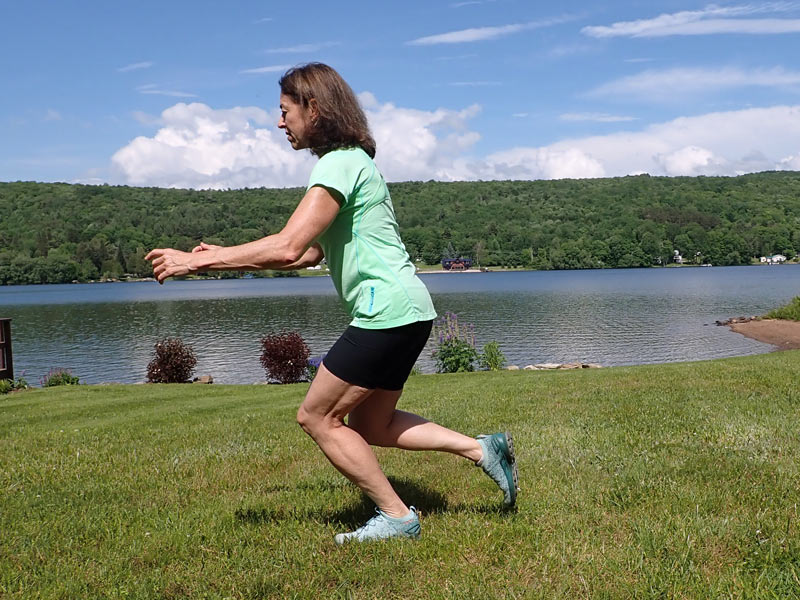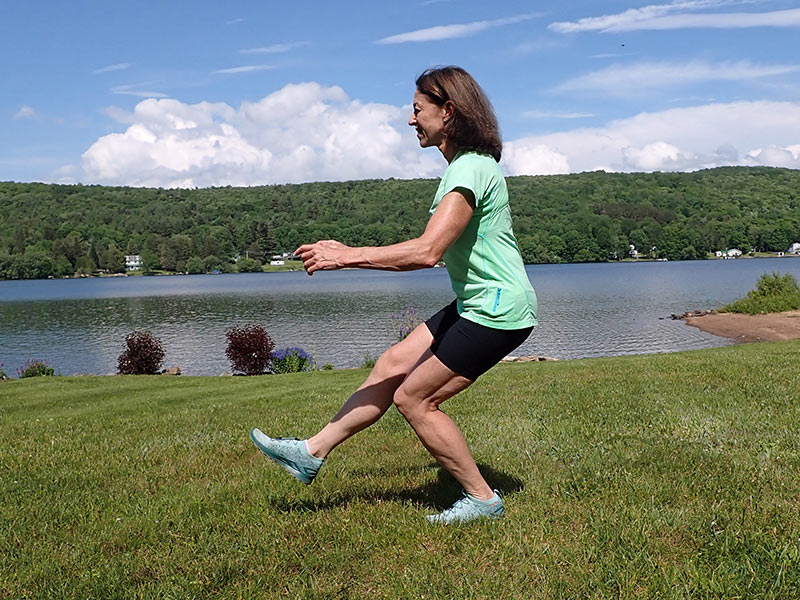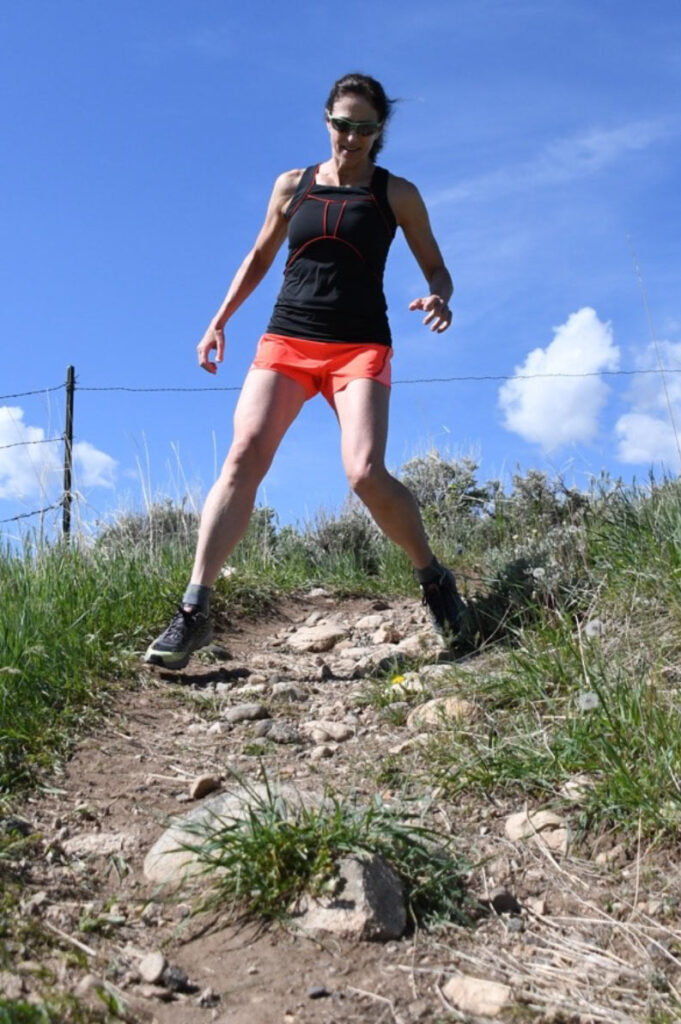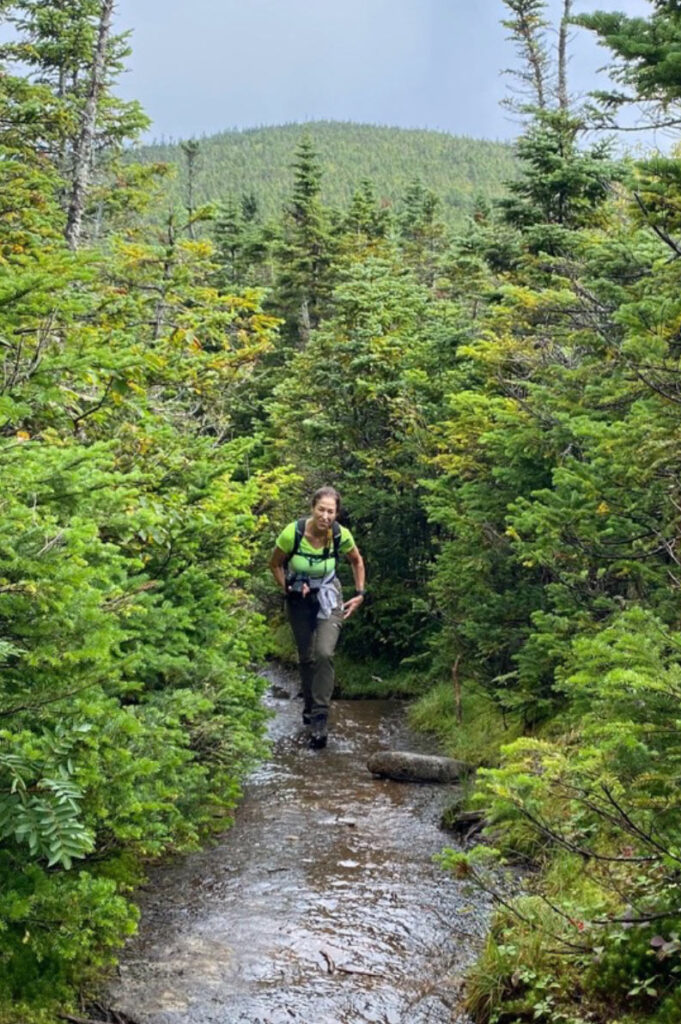BUILDING STRENGTH, POWER, ENDURANCE, STAMINA:
June 19, 2025. One of the most common questions I’m asked is “how should I get in shape for ski season?” Let’s start by saying attention to physical conditioning is not only an off-season endeavor. If you work hard throughout the summer and fall to get in shape for winter, then stop your off-snow or “dryland” training once you get back on snow, your strength, quickness, and stamina slowly decline throughout the ski season. As a result, when the big events take place, typically in March or early April, you’re in the worst physical shape of the winter. It’s a balance, managing training volume versus fatigue and the need for recovery, especially as you age.
To ski faster, top racers mix doses of strength training, speed and agility drills, and other sports into a year-round regimen. The recipe changes depending on the time of year. During the off-season, improving your power, agility, balance, and flexibility are all part of a well-rounded ski conditioning program. During the winter, the goal is to maintain it.
5 AREAS OF FITNESS FOR SKIING
Conditioning for skiing can be separated into five areas of fitness:
1. Strength and power
2. Quickness and agility
3. Balance and coordination
4. Flexibility
5. Stamina and endurance
World Cup ski racers are professional athletes. It’s their job to make physical training the priority when they are not skiing. The rest of us have work, family responsibilities, and social obligations that constantly cut into workout time. Some days we might have two hours to exercise, other days only 20 minutes. Given time restrictions, it’s important to choose wisely what you do for dryland training. What you do depends on where you live, what facilities and activities you have access to, and what you like to do.
What follows are my thoughts about how to improve strength, power, stamina, and endurance for skiing and ski racing, particularly for athletes ages 40+.
[To get info on the other areas of fitness, click here.]
THE IMPORTANCE OF STRENGTH TRAINING
Strength is the most important area of fitness when it comes to skiing. Strength allows you to control your body and your skis despite the forces and vibrations in a turn. The stronger and more powerful you are, the faster you can naturally ski in all types of conditions because you can withstand higher amounts of pressure generated by your turns and absorb the rattles and shocks that your skis receive. Once you master technique, the most direct way to improve your performance is to make yourself physically stronger.
Strength is a confidence-builder. If you know you’re strong, you’ll be more self-assured, and you’ll believe in your ability to handle higher speeds and adverse snow conditions because of your off-snow preparation. Sometimes you may even find yourself skiing faster without realizing it because of your improved strength.
Strength is also your safety net. When you lose your balance, it’s your strength that helps you recover. For example, if you sit back while skiing, or worse, get suddenly thrown back off a bump, it will be your strength, particularly your core strength, that gives you the best chance of avoiding a bad crash. But first, let’s first talk about gaining ski-specific lower body strength, since faster skiing starts from the feet and legs up:
LEG EXERCISES FOR SKIING
Ski racing is an eccentric sport, meaning the muscles must lengthen under tension, which produces a pulling sensation. For these reasons, it’s important to include eccentric exercises in your off-snow conditioning program. Here are a couple of standards:
Eccentric squats: Slowly lower yourself into a squat (3+ seconds), then quickly raise back up. Most athletes do squats in the weight room with a bar on their shoulders or dumbbells in each hand. Keep the amount of weight reasonable, especially at first.

Eccentric lunges: Slowly lower yourself into a lunge (3+ seconds), then come up quickly as you switch the lead foot, either by stepping forward or springing into the air as you switch the lead foot.
Most of us have a weaker side. On the slopes, it’s the turn that’s harder or less coordinated. To balance both sides, work each leg separately. For example, if you are doing hamstring curls on a weight machine, alternate sets for the left leg and the right leg. One leg recovers while the other one lifts, and both get an equal workout.
Power on skis is an explosive yet controlled movement. It’s the focused high energy at the release of the turn that catapults you through the transition to the next turn. Plyometric exercises, which involve leaping or jumping, teach your muscles how to handle consecutive blasts of power. It’s important to start modestly, like one set of 10 reps for the first few times, or your will be sore! Those lunges with a spring to change the lead foot that I mentioned above are an example. Here are three others:
Tuck Jumps: From a low tuck position, spring forward, returning to a low tuck when you land.
Burpees: Squat placing hand on the floor. Extend your feet behind you to a plank position. Contract your feet back under your body, then spring into the air, landing back in a squat with hands on the floor.
Lateral jumps: Keeping your shoulders level to the floor and hands forward as if holding ski poles, leap as far to the right as you can landing on your right foot with your left next to it. Then leap as far the left as you can, keeping your upper body quiet the entire time, as if you are skiing.
WHAT ABOUT THE WALL SIT?
The Wall Sit is one of those classic exercises associated with dryland training. I’m not crazy about it. I think the value of this exercise is marginal as it relates to skiing, and I don’t do them.
As the name implies, to do the Wall Sit, your back rests against the wall while your knees form a 90-degree angle with your feet flat on the floor, as if you are sitting in an invisible chair. The idea is to hold this position for a period of time, e.g., 30 seconds, 1 minute, 2 minutes. As you get stronger, you hold it longer.
While the Wall Sit strengthens the quads, the knees bear most of the load. If you already have a knee injury, forget Wall Sits. In addition, the Wall Sit positions your hips well behind your feet, the equivalent of sitting too far back on skis. Finally, it’s a static “isometric” exercise. Isometrics strengthen the muscle at only the joint angle plus and minus 3 degrees. If your knees are bent at 90 degrees while doing the Wall Sit, you’re only getting stronger at 87 to 93 degrees of knee flexion, less than the range of motion in skiing.
You’re better off doing One-Leg Knee Bends, which are not static. You move up and down as if you are absorbing terrain. One-Leg Knee Bends strengthen both your hams and quads, equally work your right and left leg, and improve your balance:
One-Leg Knee Bends: Balance on one foot, with your hands forward like you’re holding ski poles. Lower yourself toward a 90-degree bend in the supporting knee. It’s OK if you don’t go completely to 90 degrees. Go as far as you can. Do half of the reps with your other leg forward and the other half with it behind you.


BUILDING LEG STRENGTH AND POWER OUTSIDE THE GYM

Even though I don’t like running, I run up to 3 miles, 2 to 3 days per week, in the off-season to improve my stamina and endurance. It gets harder and I’ve gotten slower as I get older, but I key on my heartrate, keeping runs in my aerobic zone.
Once I get that aerobic base, I change it up with interval training or “fartlek’s” - 40 to 70-second sprints alternating with recovery walking or slow jogging - to simulate full-on race runs in skiing and to build power and quickness in my legs. It’s no coincidence that 40 to 70 seconds is about the length of a slalom, GS, or super G. Fartlek’s works best on smooth, hilly terrain. The hills help build more power.
It’s easier to simply plod along, same old run, trying to trim a few seconds off the pace or add a mile, but to make running more ski-specific, you need simulate how you move on the slopes, which means quicker, shorter bursts. That’s true for everything you do to get in shape for ski season.

Maybe you cannot run because of an injury or joint replacement, you don’t have a good place to run, or you simply don’t like it. You’ve got other options. In my case, I mix in bike rides, which I enjoy, powering up the hills and getting some separation of the upper and lower body (angulation) around turns.
And I do a LOT of hiking. Climbing up a mountain strengthens my hams and glutes. Going down, works my quads, and I move my feet quickly. I don’t mean sprinting downhill. Instead of going straight downhill, which pounds my knees and hips, I do a “trail dance”, taking lots of small, quick steps, left and right, side to side. Hiking also improves my eye-foot coordination, strengthens my feet and ankles, and generally makes me “mountain-wise”.
Mountain biking is an excellent way to cross-training for ski racing, too. In addition to the strength and cardio-vascular benefits, it forces you to look ahead and stay in balance while your bike is rattling along, sometimes at a high speed.
With hiking and mountain biking, perhaps the most important value of these two sports for ski racing is that it gets you on outdoors on uneven terrain, preferably on a mountainside. Rock climbing counts, too. I believe that the more time you spend on mountains, the more comfortable you are in that environment regardless of what you are doing. Simply put, it makes you more mountain-wise. And the views are inspirational, too.
If you must workout indoors because of the weather, extensive travel, or you live in an urban place, you’ve still got this! Just remember to program that stationary bike, elliptical, rowing machine, or treadmill to do more than simply steady and straight ahead. Variety in your off-snow training is one of the secrets to skiing faster.
Never begin an exercise program without first consulting your physician. Always warm up and cool down properly to help lower the chance of injury.
Got a question or something to add?

